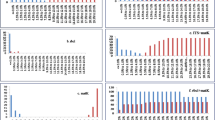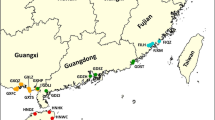Abstract
Countries' genetic resources and biological variation are extremely valuable. Biodiversity and genetic resources, particularly for endemic species, should be protected. DNA barcoding studies are a useful for identifying unknown taxa and protecting a country's biodiversity. DNA barcodes are small segments of DNA that are taxonomically informative and can be used to for species identification. DNA barcodes have been used to associate life phases, determine cryptic species, and prohibit illegal commerce, among other things. Astragalus argaeus and A. stenosemioides are endemic plant species to Turkey's Mt. Erciyes. To distinguish these two endemic Astagalus, we used two DNA barcodes in the matK region. The current study used A. argaeus, A. stenosemioides, and 23 GenBank sequences of other relative in the genus Astragalus, including one from a closely related species, to infer phylogenetic relationships and DNA barcodes for two endemic plants. The matK gene region could clearly identify A. argaeus and A. stenosemioides from closely related taxa, according to the phylogenetic study. Taxonomic and biodiversity research, as well as molecular ecology and population genetics investigations, will benefit from DNA barcoding surveys to unambiguously differentiate between these two species. Also, by separating the matK DNA gene area, which is one of the molecular features, it is feasible to detect the species, and A. argaeus and A. stenosemioides were successfully barcoded for the first time.

Similar content being viewed by others
References
Byfield A, Özhatay N, Atay S (2003) Türkiye’nin Önemli Bitki Alanları (Important Plant Areas in Turkey). WWF Türkiye (Doğal Hayatı Koruma Vakfı) Yayınları, İstanbul
Carew L, McMurtry J, Alster F (2005) Effects of lysine deficiencies on plasma levels of thyroid hormones, insulin-like growth factors I and II, liver and body weights, and feed intake in growing chickens. Poult Sci 84:1045–1050
Darriba D, Taboada GL, Doallo R, Posada D (2012) JModelTest 2: more models, new heuristics and parallel computing. Nat Methods 9:772. https://doi.org/10.1038/nmeth.2109
de Vere N, Rich TCG, Trinder SA, Long C (2015) DNA barcoding for plants. In: Batley J (ed) Plant genotyping. Methods in molecular biology (methods and protocols), vol 1245. Humana Press, New York, NY
Drummond AJ, Ho SYW, Phillips MJ, Rambaut A (2006) Relaxed phylogenetics and dating with confidence. PLoS Biol 4(5):699–710. https://doi.org/10.1371/journal.pbio.0040088
Drummond AJ, Suchard MA, Xie D, Rambaut A (2012) Bayesian phylogenetics with BEAUti and the BEAST 1.7. Mol Biol Evol 22(8):1185–1192. https://doi.org/10.1093/molbev/mss075
Ekim T, Koyuncu M, Vural M, Duman H, Aytaç Z, Adıgüzel N (2000) Red data book of Turkish plants (Pteridophyta and Spermatophyta). Van Yüzüncü Yıl University, Turkish Association for the Conservation of Nature, Ankara, p 190
Fazekas AJ, Burgess KS, Kesanakurti PR, Graham SW, Newmaster SG, Husband BC, Percy DM, Hajibabaei M, Barrett SCH (2008) Multiple multilocus DNA barcodes from the plastid genome discriminate plant species equally well. PLoS ONE 3(7):e2802. https://doi.org/10.1371/journal.pone.0002802
Ford C, Ayres K, Toomey N, Haider N, Stahl J, Kelly L, Wikstrom N, Hollingsworth P, Duff R, Hoot S, Cowan R, Chase M, Wilkinson M (2009) Selection of candidate coding DNA barcoding regions for use on land plants. J Linn Soc Bot 159(1):1–11
Hartvig I, Czako M, Kjær ED, Nielsen LR, Theilade I (2015) The use of DNA barcoding in identification and conservation of rosewood (Dalbergia spp.). PLoS ONE 10(9):e0138231. https://doi.org/10.1371/journal.pone.0138231
Hilu KW, Liang H (1997) The matK gene: sequence variation and application in plant systematics. Am J Bot 84(6):830–839
Hochbach A, Linder HP, Röser M (2018) Nuclear genes, matK and the phylogeny of the Poales. Taxon 67(3):521–536
Hollingsworth PM, Li DZ, van der Bank M, Twyford AD (2016) Telling plant species apart with DNA: from barcodes to genomes. Philos Trans R Soc Lond B Biol Sci 371:20150338. https://doi.org/10.1098/rstb.2015.0338
Hosein FN, Austin N, Maharaj S, Johnson W, Rostant L, Ramdass AC, Rampersad SN (2017) Utility of DNA barcoding to identify rare endemic vascular plant species in Trinidad. Ecol Evol 7(18):7311–7333
Johnson LA, Soltis DE (1994) matK DNA sequences and phylogenetic reconstruction in Saxifragaceae. Syst Bot 19:143–156
Kim HM, Oh SH, Bhandari GS, Kim CS, Park CW (2014) DNA barcoding of Orchidaceae in Korea. Mol Ecol Resour 14(3):499–507
Kress WJ, Horvitz C (2005) Habitat alteration in the Caribbean: Natural and human-induced. In: Krupnick GA, Janzen DH (eds) Plant conservation: A natural history approach. The University of Chicago Press, Chicago, IL, pp 147–151
Lopez-Vaamonde C, Kirichenko N, Cama A, Doorenweerd C, Godfray C, Guiguet A, Gomboc S, Huemer P, Landry JF, Lastuvka A, Lastuvka Z, Kyungmin L, Lees D, Mutanen M, van Nieukerken E, Segerer A, Triberti P, Wieser C, Rougerie R (2021) Evaluating DNA barcoding for species identification and discovery in European gracillariid moths. Front Ecol Evol 9:66
Özhatay N, Kültür Ş, Aslan S (2009) Check-list of additional taxa to the supplement flora of Turkey IV. Turk J Bot 33:191–226
Rambaut A, Drummond AJ (2009) Tracer v 1.5. http://beast.bio.ed.ac.uk/Tracer. Accessed 30 Jan 2020
Sekercioglu C, Anderson S, Akcay E, Bilgin R, Can O, Semiz G, Tavşanoğlu Ç, Soyumert A, Yokes MB, Ipekdal K, Sağlam I, Yücel M, Dalfes N (2011) Turkey’s globally important biodiversity in crisis. Biol Conserv 144:2752–2769. https://doi.org/10.1016/j.biocon.2011.06.025
Tezcan M, Vlachonasios K, Aki C (2010) DNA barcoding study on Sideritis trojana Bornm. An Endemic medicinal plant of Ida Mountain, Turkey. Fresenius Environ Bull 19(7):1352–1355
Upadhyaya HD, Gowda CLL, Sastry DVSSR (2008) Plant genetic resources management: collection, characterization, conservation and utilization. J SAT Agric Res 6:16
Valentini A, Pompanon F, Taberlet P (2008) DNA barcoding for ecologist. Trends Ecol Evol 24:110–117
Vijayan K, Tsou CH (2010) DNA barcoding in plants: taxonomy in a new perspective. Curr Sci 99(11):1530–1541
von Crautlein M, Korpelainen H, Pietiläinen M, Rikkinen J (2011) DNA barcoding: a tool for improved taxon identification and detection of species diversity. Biodivers Conserv 20:373–389. https://doi.org/10.1007/s10531-010-9964-0
Vural C, Aytaç Z (2005) The flora of Erciyes Dağı (Kayseri, Turkey). Turk J Bot 29:185–236
Vural C, Şapcı H (2012) A single locality, endemic species, Astragalus argaeus (Fabaceae). Kew Bull 67:89–92
Yule GU (1925) A mathematical theory of evolution based on the conclusions of Dr. J.C. Willis, F.R.S. J R Stat Soc 213:21–87. https://doi.org/10.2307/2341419
Author information
Authors and Affiliations
Corresponding author
Additional information
Publisher's Note
Springer Nature remains neutral with regard to jurisdictional claims in published maps and institutional affiliations.
Rights and permissions
About this article
Cite this article
Şapcı Selamoğlu, H. DNA barcoding of two narrow endemic plants; Astragalus argaeus and Astragalus stenosemioides from Mount Erciyes, Turkey. Conservation Genet Resour 14, 81–84 (2022). https://doi.org/10.1007/s12686-021-01239-y
Received:
Accepted:
Published:
Issue Date:
DOI: https://doi.org/10.1007/s12686-021-01239-y




